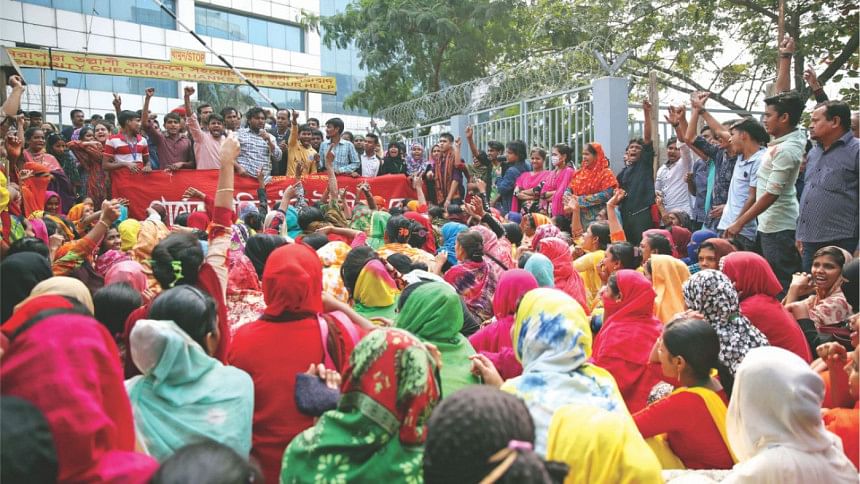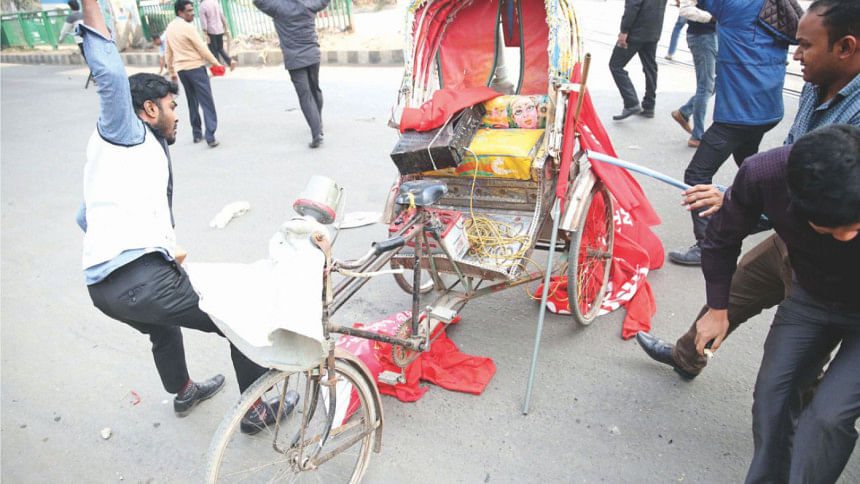Silencing the labour movement

The attempt of suppressing workers and union leaders with prolonged unlawful detention is nothing new in Bangladesh. There are too many instances in which owners use false cases as tools to crack down on labour movements. According to labour rights activists in the country and abroad, the recent detention of seven labour leaders of the Garment Worker's Trade Union Centre (GWTUC)—after initial rejection of their bail—on the basis of charges filed by the Bangladesh Garment Manufacturers and Exporters Association (BGMEA), is one such attempt to silence unions.
The case was filed against 12 labour leaders and about a hundred unnamed workers of Ashiana Garments Industries Ltd, after 400-450 workers of that factory staged demonstrations in front of the BGMEA building on January 31. Their factory had closed down until further notice and the workers had turned up in front of the BGMEA building to seek answers. They claimed that they were not there on their own accord, but that the authorities had called them in for a meeting.
According to the application to file a case made by Major (Retd) Md Rafiqul Islam, additional secretary (administration), BGMEA, on January 31, the striking workers of Ashiana Garments Industries Ltd. as well as the labour leaders were involved in violence, vandalism and attempted murder of BGMEA officials.The statement claims that the labour leaders snatched mobile phones, a laptop and money from the BGMEA officials. It also states that the workers are "criminals who carry out nefarious activities by exploiting the name of the garment workers trade union centre". Two workers named Rasel and Munna are still in jail due to this case.
So who exactly are these workers—these "criminals" by the BGMEA's standards—and why were they demonstrating in the first place?
It all began when Ashiana Garments Industries Ltd. fired a line iron man named Mamun, who was the vice president of a proposed union there. The union had been organising in the factory from April 2017.
Mamun recounts how he was fired: "On January 28, after lunch break, my production manager (PM) told me that I was being transferred to the fifth floor, and that I had to move immediately. There was only one hour left to the day, and my supervisor, to whom I was supposed to submit my work, wasn't present on the floor. So I told the production manager that I would join the fifth floor the next day. He accepted my request rationally and left."
The next day, however, when Mamun went back to the factory and reported to the PM, the latter handed him a dismissal letter. "I was shocked. I thought how could they fire me for such a simple matter, without any prior notice?"
When Mamun came back to his floor, other workers found out that he had been fired and became agitated. Khadijah, a sewing operator on Mamun's floor, says, "The workers were furious. They began to say: if a worker leader could be fired over such an insignificant matter, what job security did the rest of the workforce have? Some of them even went down to the HR department, but the HR officials didn't provide them with a satisfactory answer. All they said was that the factory wouldn't let Mamun work there."
Frustrated at the management's behaviour, the workers initiated a strike, demanding that his dismissal be withdrawn. However, the factory management did not engage them in any discussion, or even ask them to stop the strike, claim the workers.
On the following day (January 30), when the workers came back to work, they found the main gate closed, with a closure notice on the gate under Section 13 of the Labour Law for "illegal strike". Although the workers waited in front of the gate, the management did not speak to them till noon. After 12 pm, workers note, some officers of the BGMEA, Officer-in-Charge of Rampura Police Station and officers of the Department of Inspection for Factories and Establishment (DIFE) told them to go to the BGMEA office the next day (January 31) to attend a meeting.
Shah Alam, a sewing operator at the Ashiana Garments Industries Ltd, informs us that the following day, they went to the BGMEA building and asked the security personnel if anyone from Ashiana factory had arrived to hold a meeting, but did not receive an answer. "We were waiting there and protesting peacefully. A trade union leader was giving a speech. At one point, some officials of the BGMEA came down and had an altercation with the leader who was speaking. They seized our banners and microphone and even broke the rickshaw, which was carrying it," says Alam. "The security staff and officials beat us up with wooden rods and pieces of broken bricks. After a while, nearly a hundred men with steel pipes and iron rods stepped down from the BGMEA building and started beating us. In fact, the police also charged at us with batons," he adds.

Mamun admits that there was violence on both sides, but asks, "What were the workers to do when armed goons charged upon them? At least 26 of our workers had to be admitted in Dhaka Medical Hospital for treatment, whereas only two or three persons were injured on their side. They were the ones who called us to the BGMEA, but instead of talking to us, they beat us up and then filed a case against us."
When the workers went to file a case against the BGMEA officials, the Rampura thana OC didn't take their case, adds Mamun.
Md Rafiqul Islam of BGMEA would not talk about the case he filed. However, another high official of BGMEA, on condition of anonymity, claims that the BGMEA did not ask the workers to come for a meeting. However, Syed Nayem Kabir, Admin and Compliance Manager at the Ashiana Garments Industries Ltd, admits that they informed Ahad Ansari, one of the BGMEA officials, about a meeting to be held on January 31. The workers also claim that the factory authorities had come to BGMEA that morning.
Of the 12 labour leaders named and subsequently detained in the case, three, including the president and general secretary of the union, weren't even present on the BGMEA premises on January 31. When asked why the leaders had been charged, the BGMEA official informs us that they might have "instigated other leaders and workers." The official refused to be quoted as he was not authorised to give any statement to the media.
But why was Mamun dismissed? Was he fired simply because he did not join another section when there was only one hour left of the work day?
The leaders of the GWTUC claim that this is not the case.
Monjur Moin, who spent nine days in jail before being released on April 9, states that Mamun was fired because he was unionising the workers. "Since he was the vice president of the proposed union of the factory, it was nothing but a technique to stop the unionisation process by rusticating him for good," says Moin.
According to Mamun, the factory authority targeted him from last April, when the union submitted the necessary papers for union registration. "Although we united 380 of the 500 workers for the union, the Joint Director of Labour (JDL) rejected our proposal. At the same time, the factory owners proposed another union, where all the leaders are factory administration staff and none of the workers even know about it," claims Mamun.
Admin and compliance manager of Ashiana, Syed Nayem Kabir alleges that the JDL rejected the submission as Mamun, along with five workers, faked signatures of other workers. "Another worker submitted papers for union and got approved. We have nothing to do here," he says.
Last year, in April, the authorities even bribed the local police to beat him up and lock him in a room of the factory, he alleges. Later, he made phone calls to trade union leaders who sent a police officer from the Rampura Police Station to diffuse the situation. According to Mamun, the officer took a written agreement from the General Manager of the factory, in which he pledged that should any further harm happen to Mamun, the GM would be held responsible.
The authorities denied Mamun's claims.
"I was working again to get papers ready for union registration, which I submitted this February. More than 70 percent workers supported the union. And it was the main reason why they fired me," says Mamun.
The dismissal letter obtained by Star Weekend states that Mamun was dismissed for failure to act as per the instructions of the production manager and managing director.
However, according to Article 195(c)(d) of the Bangladesh Labor Act 2006: "No employer ... shall ... discriminate against any person in regard to any employment ... on the ground that such person is, or is not a member or officer of a trade union; dismiss, discharge, remove from employment or threaten to dismiss, discharge or remove from employment a worker or injure or threaten to injure him in respect of his employment by reason that the worker is or proposes to become, or seeks to persuade any other person to become a member or officer of a trade union, or participates in the promotion."
Given that the management was well aware that Mamun was a trade union leader, their dismissal of him, under Bangladeshi laws, is retaliatory and hence illegal. In a country where trade unions are silenced at every step, the management's efforts to not only dismiss a popular labour leader but subsequently file cases against workers protesting against the injustice, sends a grave signal about the sector's commitment to protect freedom of association.
Furthermore, labour activists believe that the false case against the central leaders of GWTUC is politically motivated as GWTUC has been at the forefront of the movement for higher wages—and is a further affront on workers' freedom of association.





Comments